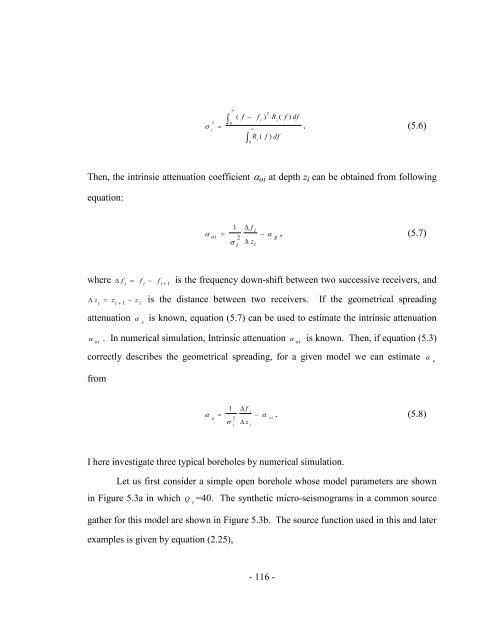My PhD Thesis, PDF 3MB - Stanford University
My PhD Thesis, PDF 3MB - Stanford University
My PhD Thesis, PDF 3MB - Stanford University
Create successful ePaper yourself
Turn your PDF publications into a flip-book with our unique Google optimized e-Paper software.
2<br />
i<br />
<br />
0<br />
<br />
( f f ) i 2<br />
R ( f ) df<br />
i<br />
<br />
0<br />
<br />
R i ( f ) df<br />
- 116 -<br />
. (5.6)<br />
Then, the intrinsic attenuation coefficient oi at depth zi can be obtained from following<br />
equation:<br />
oi <br />
1<br />
2<br />
i<br />
f i<br />
z i<br />
g , (5.7)<br />
where f i f i f i 1 is the frequency down-shift between two successive receivers, and<br />
z i z i 1 z i is the distance between two receivers. If the geometrical spreading<br />
attenuation g is known, equation (5.7) can be used to estimate the intrinsic attenuation<br />
oi . In numerical simulation, Intrinsic attenuation oi is known. Then, if equation (5.3)<br />
correctly describes the geometrical spreading, for a given model we can estimate g<br />
from<br />
g <br />
1<br />
2<br />
i<br />
f i<br />
z i<br />
oi . (5.8)<br />
I here investigate three typical boreholes by numerical simulation.<br />
Let us first consider a simple open borehole whose model parameters are shown<br />
in Figure 5.3a in which Q p =40. The synthetic micro-seismograms in a common source<br />
gather for this model are shown in Figure 5.3b. The source function used in this and later<br />
examples is given by equation (2.25),
















